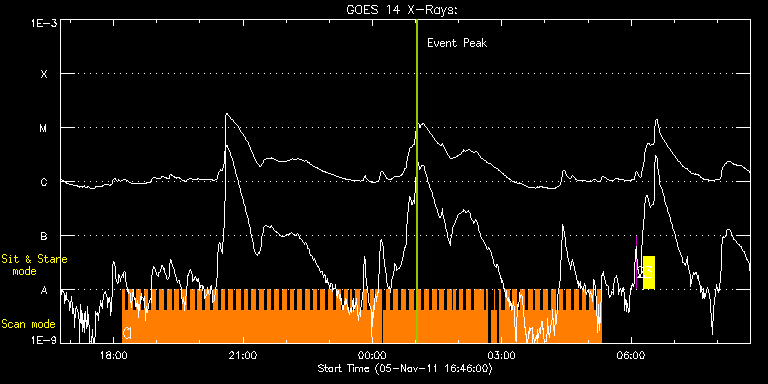The EIS flare catalogue
The current solar cycle, cycle 24, was slow to start but in 2011 a rapid rise in the sunspot number occurred which brought about more solar activity. To facilate finding solar flares that have been observed by the partial-Sun EIS observations, an EIS flare catalogue was established in February 2011. Since then, the Sun's activity has continued to increase with some very energetic flares having occurred, including the first X-class flare of the cycle. In this nugget we celebrate the first year of the EIS flare catalogue and the wonderful observations that are being collected.

Figure 1 - EIS Observation timeline overlay on the GOES X-ray curve
Accessing the flare catalogue
The catalogue is accessed via the
Hinode/EIS website hosted at UCL-MSSL. Flare events can be seen by year in the lists or the database can be searched. Once a flare event is identified, a link takes you to a summary page showing the location of the EIS observations overlaid on a full Sun context image and also
a timeline showing the EIS observations against the context of the GOES X-ray data (see Figure 1). Both context images show whether the observations are slit or slot and the details of the slit/slot width. From this same page you can view thumbnails of the EIS data, download the data files and find more information on the EIS study that was used.
There are over 4000 entries in the EIS flare catalogue and since the introduction of the EIS flare trigger programme there are also an increasing number of events where the impulsive phase of the flare is caught. One such example is the
M2.6 GOES X-ray flare that occurred on 26 September 2011.
If you are interested in flare observations you can see a selection of suitable
EIS study options here.
Feel free to contact us to run flare observations on the active regions you are interested in studying. With the long-term future of sunspot activity looking likely to decline in the coming decades, make the most of the activity in cycle 24!


